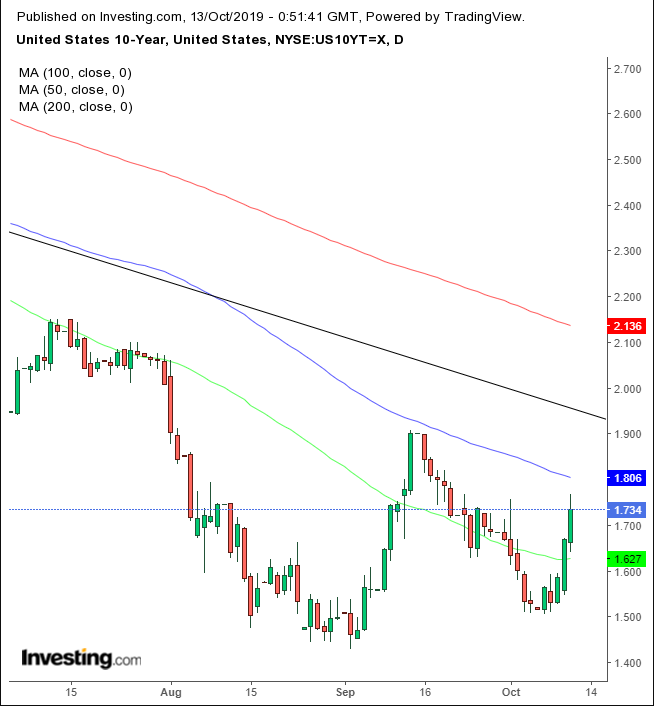Positive U.S.-China trade rhetoric and the possibility of a deal on Brexit should drive ongoing rallies in the week ahead. When news broke on Friday regarding the developements, stock indices—including the S&P 500, Dow Jones, NASDAQ Composite and the UK's FTSE 250—jumped, while sterling leaped. Treasurys, on the other hand plunged.
Although China is taking a tougher stance on the situation even as the U.S. capitulates on additional new tariffs while agreeing to work out remaining demands at a later date, this initial step, ahead of the U.S. 2020 election, provides the space for Liu He, China’s Vice-Premier to shake hands with President Donald Trump after announcing a “phase one” agreement to ease the ongoing trade dispute.
The dramatic trade developments have, at least for the moment, overshadowed recent economic data suggesting the U.S. might be joining the global slowdown.
Biggest Weekly Equity Gains in Four Months
Positive comments on the Brexit front added to the optimism, leading global, developed market stocks to record their biggest weekly rise in four months.
All four major U.S indices gained more than a full percent on Friday, with the S&P 500 (+1.09%) underperforming. The Russell 2000 (+1.63%) outperformed, followed by the NASDAQ Composite (+1.34%) and the Dow Jones Industrial Average (+1.21%).
Eight of the 11 market sectors were deeply in the green, with the defensive Health Care sector (+0.83%) providing the lowest returns. The three sectors in the red were also defensive—Utilities (-0.37%), Real Estate (-0.38%) and Consumer Staples (-0.1%). Materials (+1.94%) outperformed, followed by Industrials (+1.88%) and Technology (+1.38%), all trade related sectors.

From a technical perspective, as predicted, the S&P 500 Index bounced in early October, though it cut through the 2,960 area we expected would hold as a resistance. However, the extreme shooting star demonstrates that supply inundated demand, signaling a potential decline this coming week. However, if the price breaks through the 3020 level, it would suggest continued rallies. Particularly striking: despite the positive turnabout, bears still forced bulls to close at prices significantly off their highs.

Yields on the U.S. 10-year Treasury note jumped for the third straight day, but stopped short of approaching the 100 DMA. This protects the downtrend line, in place since November 2018.

At the same time, the dollar fell along with yields. The USD found support by the bottom of its rising channel since June. The Chinese yuan climbed the most in a month.

Crude gained after OPEC Secretary General Mohammad Barkindo said on Thursday members and allies including Russia will do “whatever it takes” to prevent another oil slump as the global economy weakens.
Technically, the commodity's price rose for the first time in four weeks, bouncing off the bottom of a descending channel and cutting through the 200 WMA. Should the pattern provide a downside breakout, it would signal dramatically lower prices ahead.
Week Ahead
All times listed are EDT
Sunday
23:00: China – Trade Balance: expected to rise to $36.30B USD, from $34.84 the month previous.
Monday
20:30: Australia – RBA Meeting Minutes
Tuesday
5:00: Germany – ZEW Economic Sentiment (Oct.): seen to have fallen to - 27.3 from -22.5 the previous month.
Wednesday
4:30: UK – CPI: forecast to tick up to 1.8% from 1.7% YoY.
5:00: Eurozone – CPI: expected to decline to 0.9% from 1.0% YoY.
8:30: U.S. – Core Retail Sales: forecast to rise to 0.2% from 0.0% MoM; Retail Sales likely to edge down to 0.3% from 0.4%.
8:30: Canada – Core CPI: expected to remain at 1.9% YoY.
10:30: U.S. – Crude Oil Inventories: forecast to drop to 1.413M from 2.927M.
20:30: Australia – Employment Change: expected to plunge to 15.0K from 34.7K.
Thursday
4:30: UK – Retail Sales: to climb to 0.1% from -0.2%.
8:30: U.S. – Building Permits: seen to drop to 1.360M from 1.425M.
8:30: U.S. – Philadelphia Fed Manufacturing Index: forecast to slump to 8.0 from 12.0.
22:00: China – GDP: expected to edge down to 6.1% from 6.2% YoY.
22:00: China – Industrial Production: anticipated to climb to 5.0% from 4.4%.
